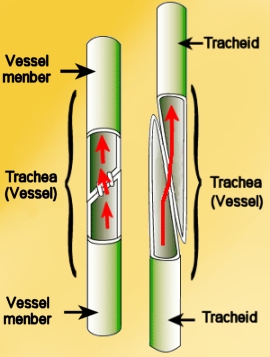| PLANT CELL TYPES
|
| 1.
|
PARENCHYMA - most
numerous cells in young plants. These cells are living when they
perform their function (although may still serve intended purpose when
dead, e.g. phellem). |
| |
-
Shape: commonly polyhedral –
variable or shaped like soap bubbles with a large central vacuole.
-
Cell Wall: Usually have thin
walls consisting of a primary cell wall and shared middle lamella or
primary and secondary, may be lignified, suberized or cutinized
-
Location: can be found in many
regions of the plant. Parenchyma tissue occurs in the cortex, pith,
pith rays, xylem and phloem.
-
Function: Parenchyma performs
many of the living functions of the plant, including respiration,
digestion, photosynthesis – essentially all metabolic functions.
Storage & conduction tissues frequently contain parenchyma. Most store
substances such as starch and lipids: Leaves have important parenchyma
cells that are specialized for photosynthesis
|
| 2. |
COLLENCHYMA - an elongated supporting cell with thick cell walls
that remains alive. Primary cell wall is thickened, no secondary
cell wall.
|
| |
-
Shape: elongated
-
Cell Wall: primary only,
highly hemicellulosic and pectic, not lignified.
-
Function: Living at maturity.
Provides more flexible support to tissues than sclerenchyma cells. The
primary distinguishing character is that it is extensible. Since it
depends on turgor, it is sensitive to wilting.
-
Location: Collenchyma may be
distributed peripherally as a cylinder in young stems (just beneath
the epidermis) or only in patches in ribs also supports petioles,
nonwoody shoots, growing organs.. Collenchyma is also found along the
veins in leaves of dicots.
|
|
3. |
SCLERENCHYMA - Often dead at functional maturity, but may remain
living. generally very long. Have heavily thickened secondary
walls because their main function is support, must be
distinguished in fibres and sclereids: |
| |
I |
FIBRES - provide for rigid support in wood
(e.g., bark) and other parts and are typically nonliving cells.
|
| |
|
-
Shape: very long and organized
into bundles.
-
Cell wall: primary and thick
secondary walls – often lignified.
-
Location: Sometimes in cortex
of stems, most often associated with xylem and phloem. Also found
particularly in the leaves of monocots.
|
| |
II |
SCLEREIDS - variously shaped and densely packed as in nut shell or
other seed coats.
|
| |
|
-
Shape: Often isodiametric;
usually shorter than fibres.
-
Cell wall: primary and thick
secondary walls - generally lignified.
-
May be living or dead at
functional maturity.
|
| 4 |
TRACHEARY ELEMENTS - Elongated tapering, |
| |
I |
TRACHEIDS -
Elongated tapering,
dead at functional
maturity |
 |
| |
|
|
| |
II |
VESSEL MEMBER
- Elongated tapering, Dead at functional maturity. |
| |
|
- Shape: Vessels are composed
of vessel members in series connected by perforation plates.
- Cell wall: primary and
secondary, lignified.
- Function: Xylem Chief
water-conducting element in Angiosperm xylem.
|
| 5 |
SIEVE ELEMENTS - elongated, tapering. Cells are living in their
functional state. Higher plants’ sieve cells lack a nucleus at
maturity, but some lower vascular plants are exceptional.
Tonoplast often not discerned at functional maturity. |
| |
I |
SIEVE CELL - very long |
| |
- Shape: very long
- Cell wall: primary in most species, with sieve
areas on the walls. Sieve areas are wall areas with pores
through which the protoplasts of adjoining cells are connected.
Callose is often associated with wall and pores.
- Function:: Phloem Chief food-conducting
element in phloem of gymnosperm and lower vascular plants.
|
| |
II |
ALBUMINOUS CELL - |
| |
|
- Cell Shape: generally elongated.
- Cell Wall: primary. Cells are living in their functional
state and are
associated with sieve cells, although they are generally not
derived
from same mother cell as sieve cell.
- Location: Phloem
- Function: Believed to play a role in movement of food
into and out of the sieve cell
|